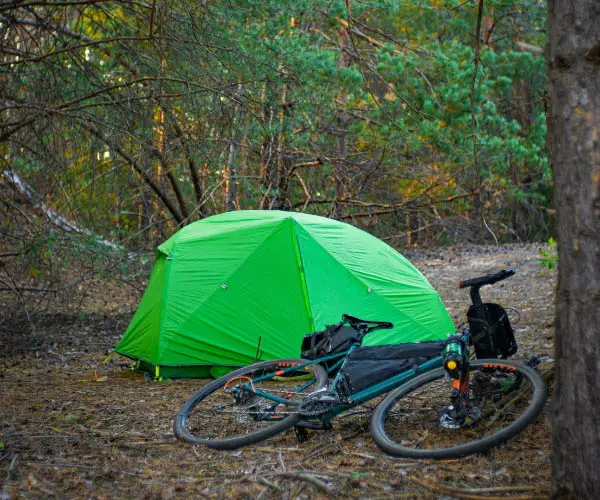Embark on an exciting bikepacking adventure with your family or friends, and experience a refreshing alternative to conventional car travel.
Bikepacking offers a unique travel experience that stands apart from typical trips. Instead of merely traveling from point A to point B during a cycling trip, bikepacking immerses you in the entire journey, taking you through diverse environments and atmospheres. This allows you to fully appreciate the landscapes, weather, and scents, free from the constraints of roads and traffic.
It's the perfect opportunity to engage in outdoor adventures, strengthen relationships, and create unforgettable memories with parents, children, and loved ones.
From setting up bivouacs to mountain bike and hiking under the sun, discover the essential bikepacking tips you need to ensure your family adventure cycling trip is a resounding success. Whether you're a beginner or an experienced cyclist, our guide covers everything from choosing the right adventure bikes to planning family-friendly bike routes. Equip yourself with the bikepacking essentials and prepare for an exhilarating weekend of adventure cycling with friends or with kids. Explore the joy of bikepacking adventures and make the most of these precious days on the trails.
Choosing your route
Distance and duration of your stay
When organizing a bikepacking trip with family or friends, it's essential to assess the bikepacking with family and kids needs. Consider the bikepacking essentials to ensure everyone's comfort. For a weekend getaway, plan a bikepacking trip lasting one to three days. Opt for shorter stages and family-friendly bike routes to fully enjoy each stop and create memorable bikepacking adventures.
Choosing the right difficulty level for everyone
Selecting a route that matches the fitness and experience levels of all participants is crucial, especially when adventure cycling with friends or family. For those new to the sport, choose trails or paths with gentle, well-maintained gradients. This consideration helps in promoting an enjoyable experience on adventure bikes for everyone involved.
A sporting or touristic itinerary ?
Are you planning a bikepacking with family or a more rugged adventure cycling experience? For your first outing with kids, whether they're small children, teenagers, or even a baby, opt for well-maintained family-friendly bike routes like greenways, cycle routes, or towpaths along France’s scenic rivers and canals. These choices offer safe and accessible bikepacking with kids options, ensuring everyone enjoys the ride without any worries.
During your journey, be sure to explore the local towns, restaurants and monuments, making each stop a discovery of the local heritage and gastronomy.
For accommodation, local campsites and gîtes provide delightful spots for a comfortable night’s stay. If you’re inclined towards an authentic experience, consider camping out under the stars and check the local regulations on bivouacking in the area you are exploring.
For adventure-seeking cyclists, the picturesque back roads and trails through valleys and passes will provide the elevation gain and thrill you're looking for. Mountain biking required!

Bike rental
Whether you need a mountain bike for challenging trails, a gravel bike for mixed terrains, or an electric-assist bike (EAB) to help with uphill climbs, renting a bike lets you select the perfect type for your adventure. This convenient option allows you to arrive at your starting point, pick up your bike, load up your gear, and begin your excursion right away.
Rental services often include helpful accessories such as panniers, luggage racks, and repair kits, thus simplifying the organization of your family bikepacking weekend. You might also consider renting a bike that is already outfitted for camping, allowing you to embark on your journey without the worry of forgetting essential gear.
Additionally, renting a bike gives you the opportunity to test various bike models before committing to a purchase, ensuring you choose one that offers the best comfort, handling, and performance for your needs.
Transporting children on a bikepacking Holiday
When you plan a bikepacking adventure with children, selecting the appropriate gear is crucial for their safety and comfort. For kids who are ready and able to cycle, having their own adventure on two wheels allows them to participate actively in the family bikepacking trip. For younger ones, investing in children’s bike seats or trailers ensures they travel securely and comfortably.
Children's bike seats
Typically mounted behind the saddle, these seats are suitable for children who can sit independently, usually from 9 months to 2 or 3 years old. It's important to choose seats that feature adjustable safety harnesses, footrests, and a high backrest for proper support. Ensure the seat is compatible with your bike and securely installed to prevent any accidents.
Trailer for Children
Trailers are excellent for carrying one or more older children during bikepacking adventures. They provide ample space for their essentials and can often be transformed into pushchairs for use off the bike. Opt for models with robust suspension and ventilation to enhance comfort, as well as safety features like lights for better visibility. However, be mindful that bikepacking on rough trails is not suitable when using a children’s trailer, which is best suited for tarmac roads or smooth tracks.
Integrating these bikepacking essentials and choosing family-friendly bike routes can make your adventure cycling with friends and family a memorable and enjoyable experience.
Equipment and materials for an optimal stay
Bikepacking Bags
Ensure that each bikepacker—whether adult, child, or teenager—has robust, waterproof bags to transport their gear and clothing. Opt for handlebar, saddle, and frame bags to better distribute and optimize the storage of your belongings.
Spread the load evenly among group members to prevent unbalanced loads.
Tent and sleeping bag
For those who prefer camping or bivouacking over staying in traditional accommodations, choose a lightweight, compact tent that offers protection from the elements and insects. A waterproof sleeping bag that is suitable for the temperatures of the place you stay will ensure optimum comfort.
Comfortable, insulating sleeping mats will protect you from the discomfort of sleeping directly on the cold, hard ground.
Evening at the bivouac
Bring a portable camping stove for cooking hot meals, and remember to pack essential cooking utensils. A small saucepan, a cup, cutlery, and a can opener will come in handy for meal preparation. Also essential is a headlamp, which serves as a vital source of light for navigating and engaging in nocturnal activities. And remember to pack suitable clothing to protect against the cold and dampness, including a change of clothes for extra comfort and hygiene.

Food and water
Meal planning
Plan simple, nutritious meals that can be easily prepared on a camping stove. Choose lightweight, high-energy foods such as cereal bars, dried fruits, and dehydrated meals, which are perfect for maintaining energy levels while minimizing pack weight.
Water supply
Water is your most crucial resource on a bikepacking trip, particularly when cycling all day under the sun, and even more so with kids or a baby! Plan your route with stops at reliable water sources and ensure each group member has adequate water supply, especially in hot or dry conditions. Equip yourself with water bottles, a backpack with a hydration reservoir, or other hydration systems. Additionally, carry water purifying tablets or a water filter if you are unsure about the quality of the water.
Safety and preparation for bikepacking with family and friends
Safety equipment
For a smooth and secure experience during your bikepacking experience, ensure every rider is equipped with essential safety gear. This includes a helmet, a first aid kit, a headlamp, and a signal whistle. Additionally, confirm that all adventure bikes are in excellent condition before you embark. Carrying multi-purpose tools, spare inner tubes, and puncture kits is crucial to handle any situation that may arise
Communication
Before beginning your family bikepacking trips, share your itinerary with a trusted contact. It's vital that each member of your group knows how to reach emergency services if necessary. Bring along external batteries for your phones to maintain communication capabilities at all times. Utilizing GPS devices or cycling-specific apps will help you navigate family-friendly bike routes and keep you on track.
Planning a weekend of bikepacking adventures with loved ones is not only rewarding but also an exciting adventure cycling with friends opportunity. These preparatory steps will help ensure that your journey is enjoyable and safe, allowing both adults and children to fully appreciate the outdoors. Prepare to create lasting memories on your next beginners guide to bikepacking weekend.
So, saddle up your bikes and gear up for an unforgettable journey!




